Bahía Portete – Kaurrele National Natural Park
Bahía Portete – Kaurrele National Natural Park (Spanish: PNN Bahía Portete – Kaurrele) is a national natural park in Uribia, La Guajira, Colombia. The northernmost national park of mainland South America is located at the Caribbean coast of the La Guajira peninsula in Bahía Portete, between Cabo de la Vela and Punta Gallinas. Established on December 20, 2014, it is the most recently designated national park of the country. As of 2017, 59 nationally defined protected areas are incorporated in Colombia. The park hosts a high number of marine and terrestrial species.
| Bahía Portete – Kaurrele National Natural Park | |
|---|---|
| PNN Bahía Portete – Kaurrele | |
 Bahía Hondita, close to the park | |
 PNN Bahía Portete – Kaurrele | |
| Location | |
| Nearest city | Uribia |
| Coordinates | 12°07′00″N 72°02′00″W[1] |
| Area | 14,080 ha (54.4 sq mi) |
| Designation | National Natural Park |
| Established | 20 December 2014 |
| Administrator | SINAP |
| Official website | |
Description

Bahía Portete – Kaurrele National Natural Park, with an area of 14,080 hectares (34,800 acres), is located in the extreme north of Colombia, at the northern coast of La Guajira peninsula between Cabo de la Vela and Punta Gallinas, Colombia's mainland northernmost point. The park is within the boundaries of the municipality Uribia. The climate is hot and arid, due to the desert of La Guajira. Average temperatures range between 28 and 30 °C (82 and 86 °F). The coastal area is characterised by humidity caused by the inland winds.[2] The marine bay area has an average depth of 9 metres (30 ft), ranging from 3 to 20 metres (9.8 to 65.6 ft).[3]
At the Spanish conquest in the sixteenth century, the bay was known as El Portichuelo, an area where slaves were brought into Colonial Colombia. The sparsely populated area is inhabited by approximately 500 indigenous Wayuu.[1][4] On April 18, 2004, approximately forty paramilitaries tortured and assassinated six people, four of which were women. They burned various houses and dishonoured their cemeteries. More than 600 Wayuu fled to Venezuela.[5]
Bahía Portete – Kaurrele National Natural Park was designated number 59 of the National Natural Parks of Colombia to protect the marine and littoral ecosystems of the La Guajira peninsula on December 20, 2014.[3] The declaration of the park as a protected area was initiated in 2003. The indigenous communities of the Wayuu, Kamushiwoü, Alijunao, Yariwanischi, Puerto Portete, Ian, Youlepa, Kayuuswaarraaloü and Punta Cosos Espacios contributed in the planning of the establishment of the protected area.[6][7] At the declaration of the park, president of Colombia Juan Manuel Santos said "Biodiversity is to Colombia, what oil is for the Arabs".[8] Mining and industrial fishing are prohibited.[9]
Biodiversity

Bahía Portete – Kaurrele Park comprises 25 species of reptiles and amphibians, relatively few mammals and marine fauna of 217 species have been registered in Bahía Portete.[10] The biodiversity of the park is rich in various other species.[11][12]
Fauna
| Name | Species | Image |
|---|---|---|
| nine-banded armadillo | Dasypus novemcinctus |  |
| southern long-nosed bat | Leptonycteris curasoae |  |
| red-tailed squirrel | Sciurus granatensis splendidus | .jpg.webp) |
| crab-eating fox | Cerdocyon thous aquilus | 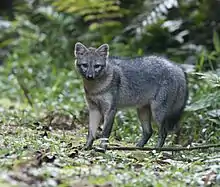 |
| white-lipped peccary | Tayassu pecari |  |
| brown hairy dwarf porcupine | Coendou vestitus | |
| American crocodile | Crocodylus acutus | 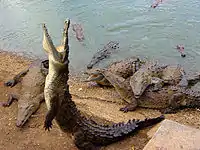 |
| green iguana | Iguana iguana |  |
| rainbow whiptail | Cnemidophorus lemniscatus |  |
| brown vine snake | Oxybelis aeneus | _(10598997254).jpg.webp) |
| South American rattlesnake | Crotalus durissus | .JPG.webp) |
| green sea turtle | Chelonia mydas |  |
| loggerhead | Caretta caretta | _.jpg.webp) |
| hawksbill sea turtle | Eretmochelys imbricata | 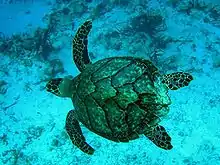 |
| leatherback sea turtle | Dermochelys coriacea | .jpg.webp) |
| olive ridley sea turtle | Lepidochelys olivacea | .jpg.webp) |
| Mastigodryas pleei | ||
| Phimophis guianensis | ||
| Rivero's toad | Bufo granulosus humboldti | |
| Guayaquil dwarf frog | Physalaemus pustulosos | |
| American flamingo | Phoenicopterus ruber | .JPG.webp) |
| anhinga | Anhinga anhinga |  |
| bicolored conebill | Conirostrum bicolor | .jpg.webp) |
| brown pelican | Pelecanus occidentalis carolinensis |  |
| cocoi heron | Ardea cocoi | _(28977964910).jpg.webp) |
| Crested caracara | Caracara plancus |  |
| magnificent frigatebird | Fregata magnificens |  |
| maguari stork | Euxenura maguari | |
| Neotropic cormorant | Phalacrocorax brasilianus | .jpg.webp) |
| roseate spoonbill | Platalea ajaja | .JPG.webp) |
| scarlet ibis | Eudocimus ruber |  |
| American white ibis | Eudocimus albus |  |
| American yellow warbler | Dendroica petechia chrysendeta |  |
| Wilson's plover | Charadrius wilsonia | 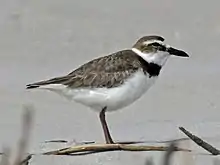 |
| slender seahorse | Hippocampus reidi |  |
| common snook | Centropomus undecimalis |  |
| hogfish | Lachnolaimus maximus |  |
| striped mojarra | Eugerres plumieri |  |
| cubera snapper | Lutjanus cyanopterus |  |
| lane snapper | Lutjanus synagris |  |
| mutton snapper | Lutjanus analis |  |
| red porgy | Pagrus pagrus |  |
| itajara | Epinephelus itajara |  |
| Nassau grouper | Epinephelus striatus |  |
| rainbow parrotfish | Scarus guacamaia |  |
| Atlantic tarpon | Tarpon atlanticus |  |
| Atlantic wreckfish | Polyprion americanus |  |
| bonefish | Albula vulpes |  |
| Tayrona blenny | Emblemariopsis tayrona | |
| Lebranche mullet | Mugil liza | |
| Cotuero toadfish | Batrachoides manglae | |
| crucifix sea catfish | Arius proops | |
| Jenny mojarra | Eucinostomus gula | |
| blue land crab | Cardisoma guanhumi |  |
| Caribbean spiny lobster | Panulirus argus |  |
| Atlantic seabob | Xiphopenaeus kroyeri | |
| queen conch | Strombus gigas |  |
| mouse cowry | Muracypraea mus |  |
| Atlantic triton | Charonia variegata |  |
| magpie shell | Cittarium pica |  |
| Cassis madagascariensis |  | |
| Haematopus palliatus | ||
| Penaeus notialis | ||
| Anachis coseli | ||
| Ancilla glabrata | ||
| Carpilus carallinus | ||
| Cassis flamea | ||
| Litopenaeus schmitti | ||
| Penaeus brasiliensis | ||
| Penaeus schmitti | ||
| red cushion sea star | Oreaster reticulatus | 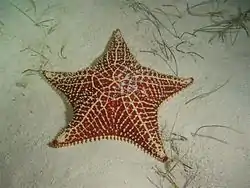 |
| spiny flower coral | Mussa angulosa |  |
| elkhorn coral | Acropora palmata | 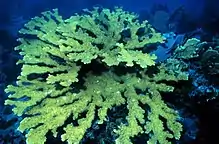 |
| staghorn coral | Acropora cervicornis |  |
| blushing star coral | Stephanocoenia intersepta |  |
Flora
The coastal Bahía Portete Park is richer in flora than the surrounding desert. Common land plants are the cactus Opuntia wentiana and the mangrove tree Avicennia germinans.[13] Meadows of sea grasses of Thalassia testudinum and Syringodium are widely distributed in the marine portion of the park.[14][15]
Other protected areas in La Guajira

La Guajira contains eight protected areas, three national and five regional.[7]
- Sierra Nevada de Santa Marta
- Los Flamencos Sanctuary
- Serranía de Macuira
- Manantial de Cañaverales
- Distrito de Manejo Integrado Musichi
- Distrito de Manejo Integrado del Perijá
- Reserva Natural de los Montes de Oca
- Distrito de Manejo Integrado Bañaderos y Alto Camarones
Gallery
 Cabo de la Vela
Cabo de la Vela
west of Bahía Portete.jpg.webp) Opuntia wentiana
Opuntia wentiana Typical cactus vegetation
Typical cactus vegetation Indigenous Wayuu
Indigenous Wayuu Taroa dunes
Taroa dunes
east of Bahía Portete
See also
References
- Gutiérrez Moreno et al., 2008, p.191
- (in Spanish) Bahía Portete – Colparques
- (in Spanish) En esquina norte de la Guajira, Bahía Portete – Parques Nacionales Naturales de Colombia
- (in Spanish) Nueva reserva de Bahía Portete aumenta áreas protegidas en el país – El Espectador
- (in Spanish) Bahía Portete, regalo de Navidad – El Espectador
- (in Spanish) Parque Nacional Natural Bahía Portete – Kaurrele – Parques Nacionales Naturales de Colombia
- (in Spanish) Bahía Portete: parque natural tiene aval wayuu – El Heraldo
- (in Spanish) Nuevo Parque Nacional Natural de Colombia Bahía Portete – Ministerio de Ambiente, Colombia
- (in Spanish) La bahía sagrada que se volvió parque nacional – El Tiempo
- (in Spanish) Biodiversidad Parque Nacional Natural Bahía Portete – Kaurrele
- Gutiérrez Moreno et al., 2008, p.199
- Díaz Pulido, 1997, p.138
- Díaz Pulido, 1997, p.89
- Díaz Pulido, 1997, p.48
- Díaz Pulido, 1997, p.52
Bibliography
- Gutiérrez Moreno, Carolina; David Alonso C., and Carolina Segura Quintero. 2008. Diseño de un área marina protegida para Bahía Portete – La Guajira, Caribe Colombiano. Boletín Investigaciones Marinas y Costeras, INVEMAR 37. 189–212. Accessed 2017-01-30.
- Díaz Pulido, Guillermo. 1997. Informe nacional sobre el estado de la biodiversidad en Colombia – Ecosistemas marinos y costeros, 1–151. INVEMAR. Accessed 2017-01-30.

.svg.png.webp)
